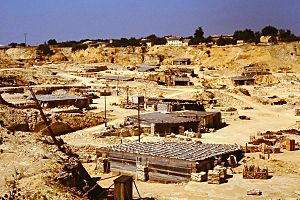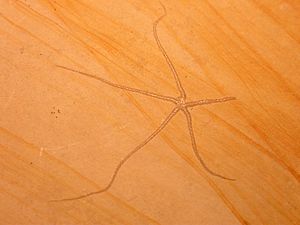Solnhofen Limestone facts for kids
Quick facts for kids Altmühltal FormationStratigraphic range: Tithonian |
|
|---|---|

Outcrop of the Solnhofen Limestone
|
|
| Type | Geological formation |
| Underlies | Mornsheim Formation |
| Overlies | Roglings Formation |
| Lithology | |
| Primary | Lithographic limestone |
| Location | |
| Coordinates | 48°54′00″N 11°00′00″E / 48.9000°N 11.0000°E |
| Region | |
| Country | |
| Type section | |
| Named for | Solnhofen |
The Solnhofen Limestone, also called the Altmühltal Formation, is a very special place in Germany. It's famous for having incredibly well-preserved fossils from the Jurassic period. This area is known as a Konservat-Lagerstätte, which means it's a fossil site where even soft-bodied creatures like jellyfish left detailed imprints!
One of the most famous fossils found here is Archaeopteryx. This early feathered dinosaur is so perfectly preserved that its fossils are considered some of the most beautiful in the world. The Solnhofen area is in the German state of Bavaria, located between Nuremberg and Munich. People originally dug up the rock here to use it for a special printing method called lithography. The Jura Museum in Eichstätt, Germany, has many amazing Jurassic fossils from Solnhofen, including ancient sea reptiles, pterosaurs (flying reptiles), and an Archaeopteryx fossil.
Ancient Environment and Amazing Preservation
About 150 million years ago, during the Late Jurassic period, this part of Germany looked very different. It was a group of islands, like an archipelago, on the edge of a large ancient sea called the Tethys Sea.
This area had calm lagoons, which are like shallow pools of water, that were mostly cut off from the open ocean. Because of this, the water in these lagoons became very salty. The bottom of these lagoons also had very little or no oxygen. This was important because it meant that most creatures that usually eat dead things (scavengers) couldn't live there.
When an animal or plant died and fell into these lagoons, it would sink into the soft, muddy bottom. Since there were no scavengers or strong currents, the dead creatures were not eaten or torn apart. This allowed even very delicate things, like the wings of dragonflies, single feathers, and land plants that washed in, to be perfectly preserved. While not a huge number of fossils are found, the ones that are discovered are spectacular. They give us a clear picture of what the Jurassic ecosystem was like in this area.
Sometimes, these lagoons almost dried up. This left behind sticky mud that trapped insects and even small dinosaurs. Scientists have identified over 600 different kinds of species from Solnhofen. These include twenty-nine types of pterosaurs, which ranged in size from a small sparrow to as big as 1.2 meters (4 feet) long!
The mud that formed the limestone in the Solnhofen area (which includes the towns of Solnhofen and Eichstätt) was very fine-grained. This made it perfect for creating lithographic plates for printing. In the 1800s, a lot of quarrying (digging for rock) happened here. This digging led to the discovery of many amazing fossils, including all the specimens of Archaeopteryx lithographica, which is even named after the lithography process.
See also
 In Spanish: Caliza de Solnhofen para niños
In Spanish: Caliza de Solnhofen para niños


